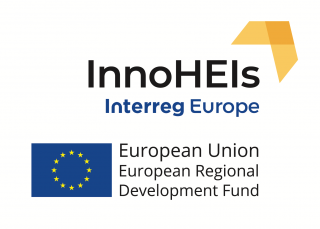Creating powerful, diverse and sustainable impact is a key driver for all actions not only in research and innovation activities in higher education institutions but also elsewhere in society, including future-oriented regional development and smart specialisation policies. The impact of a specific action can be reflected from various angles such as individual, organisation, and society as well as from various dimensions such as societal, environmental, economical. Furthermore, measuring the impact is often a great challenge.
As a follow-up of the InnoHEIs project’s virtual study visit and peer review to Tampere in May 2021, the partnership was inspired to continue the discussions around this topic in a form of an online workshop with 19 participants from the InnoHEIs partner organisations.
Impact is typically a positive and demonstrable effect or phenomenon that benefits the society outside the higher education institution, as was stated by TAMK’s Impact leader, Dr. Eeva-Liisa Viskari giving the opening keynote Impact and beyond. Impact usually takes place over a long period of time, and it might be difficult to identify, which particular research or project the change it is related to. Traditionally, impact is considered to be a result of certain input (resources), which results in measurable output and relatively concrete outcome, i.e., change in behaviour or structure, which leads towards wider impact by increased well-being and social benefit. But what if, according to a new paradigm presented by Eeva-Liisa, this chain would be flipped around, giving the impact and the original need the first voice? Would that increase the relevance and motivation in development?
The interactive group discussions focused on topics related to measuring and evaluating impact as well as its indicators. The state-of-the-art of impact assessment was reflected from both higher education institutions and regional authorities’ viewpoints, revealing the fact that the currently most utilised indicators are often very traditional, such as numbers of publications or other quantitative measures. In addition to lack of well-defined qualitative indicators, also the timeframe of the impact assessment is often limited, leaving long-term impacts unnoticed. Creating powerful and sustainable impact, with the actual societal need as a starting point, requires commonly shared values, constant dialogue and understanding of complex relationships and causalities. However difficult task this might still be, it should be tackled more intensively.
The workshop was concluded by highlighting the value of effective communication in ensuring the wider impact. The inspirational talk given by TAMK’s communication specialists Hanna Ylli and Saara Kontiainen pointed out several rules and tips how to build bridges towards impactful research and innovation. They reminded us to focus first and foremost on people, whilst still not forgetting choosing the right channels and timing. Stories and storytelling as tools to leaving memory traces and raising emotions are success factors for creating and increasing impact both in traditional and social media.
Author: Hanna-Greta Puurtinen



